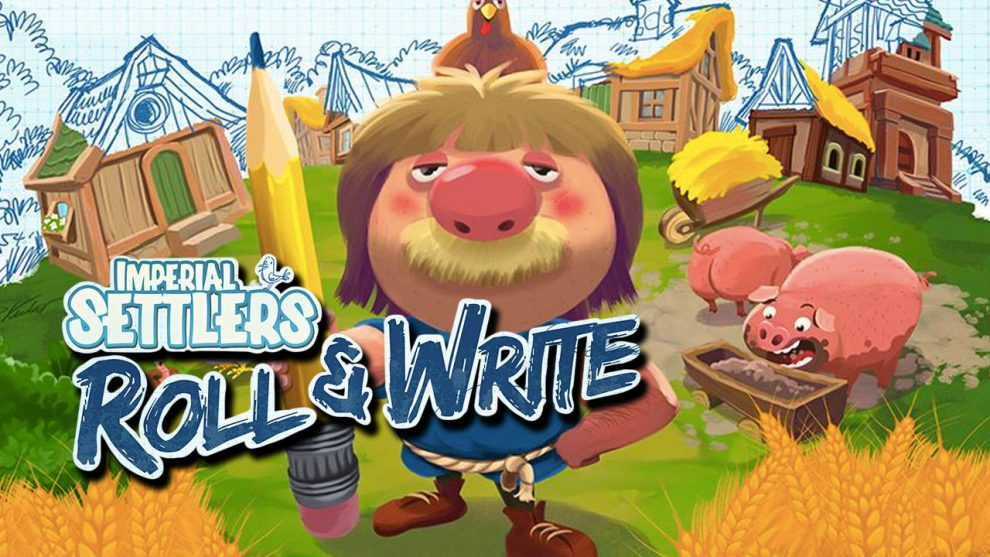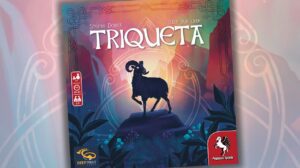Disclosure: Meeple Mountain received a free copy of this product in exchange for an honest, unbiased review. This review is not intended to be an endorsement.
Overview
Imperial Settlers, designed by Ignacy Trzewiczek, is a card game of civilization and engine building. Each player selects one of the available factions and uses that faction’s Faction deck in conjunction with a deck of Common cards to produce resources, acquire more cards, build locations, and to score points. The game is played over a total of five rounds and the person who has accumulated the most points at the end of the game wins. In a game of Imperial Settlers you start out with very little but, as the game goes on, you steadily produce more and more which has the byproduct of making each one of your future turns exponentially more explosive than the previous one.
Imperial Settlers: Roll & Write attempts to recapture this magic in the form of a roll and write game. Each turn the dice are rolled and the players perform actions using them. These actions and their results are recorded on sheets of paper. The goal is to not only put together an engine that efficiently produces the resources needed to build the various constructions in the game, but to also be the person that has accumulated the most victory points by the game’s end. How well has Imperial Settlers: Roll & Write managed to do this? You can skip ahead to the Thoughts section to find out if that’s all you really want to know. If you’re unfamiliar with the game and want to get a feel for how it’s played, though, then read on!
Setup
Each player is given an Empire sheet, a Village sheet, and a pencil. Then the Favor tokens are randomly selected (equal to the number of players plus one) and placed face up in the middle of the playing area. Any unused tokens are returned to the box. After this, a start player is selected and will roll the dice to get things started.
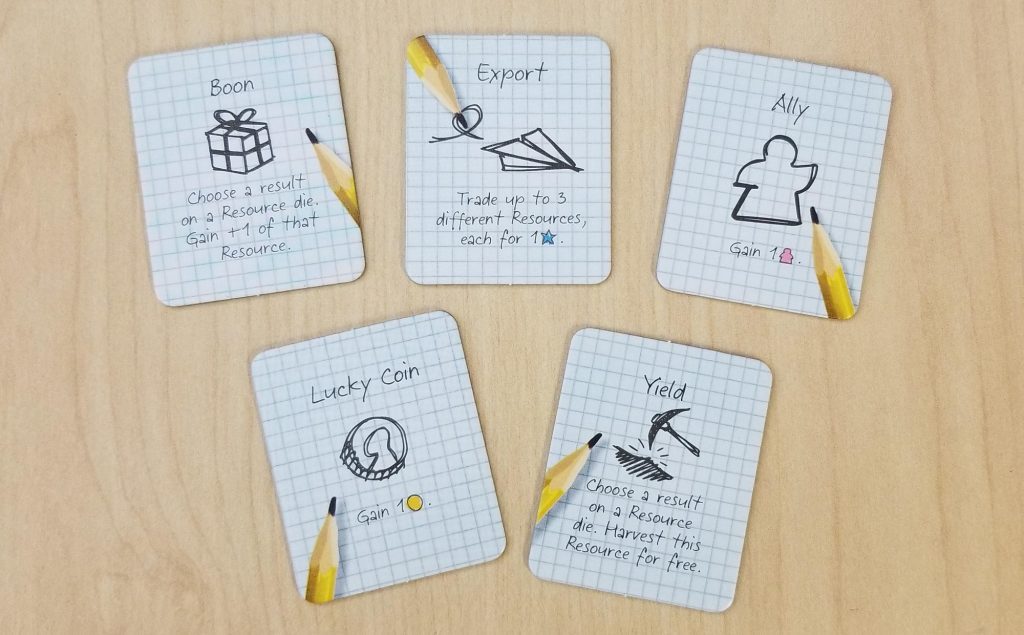
Rolling…
There are two different kinds of game dice. Three of them have different icons printed on the sides (wood, food, stone, or coin) and these determine which resources are available during each round. The other die is a pink one which features the image of a worker along with a number on each side. This die determines the base number of actions that each player will be able to perform on their turn.

In this image, each player will have 1 wood, 1 food, 1 coin, and a total of 4 actions for the round. Gold coins are wild cards and can stand in for any other resource when those resources are being used to pay for something else (i.e. – using a coin to cover the wood cost when constructing a building or filling in a space on one of the sheets).
…And Writing…
The first sheet is the Empire sheet:
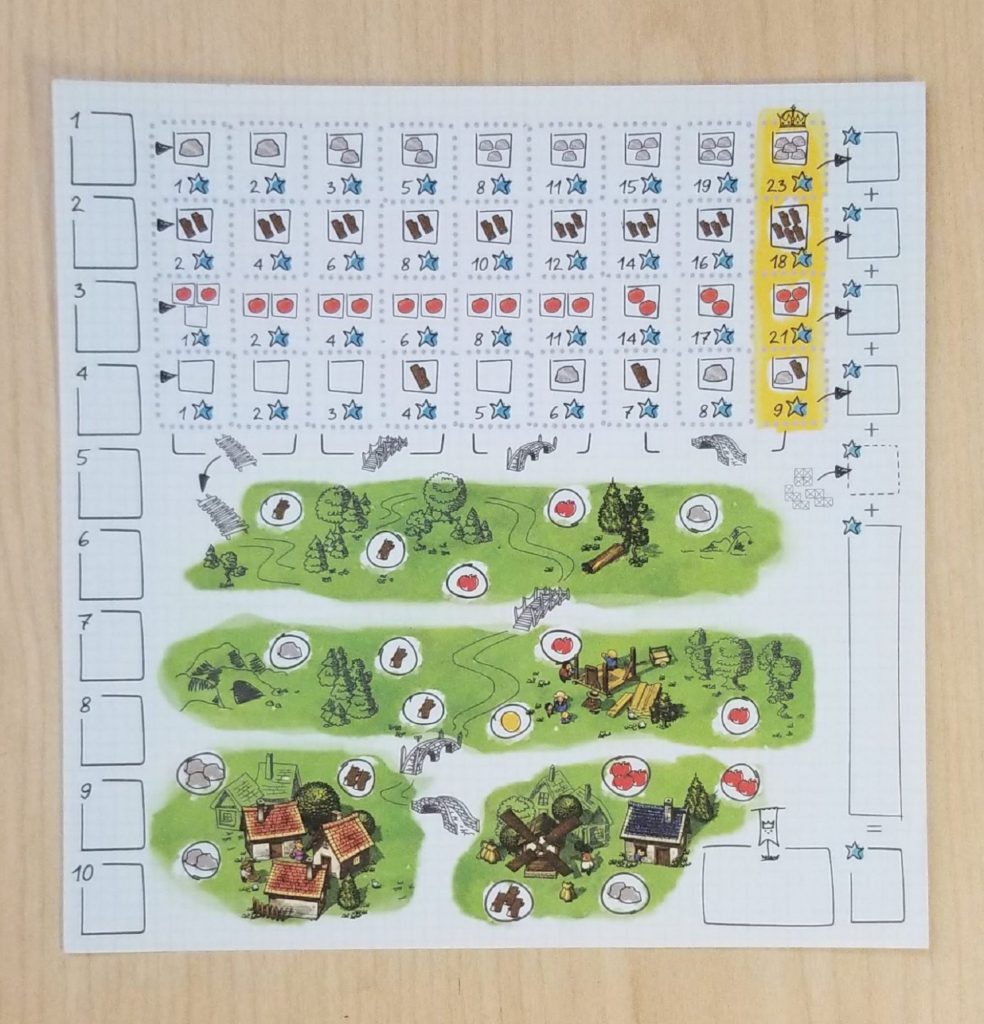
This sheet is where most of the action takes place in the game. The left column of the sheet is where the players will mark off which round they are currently in (the game lasts for 10 rounds) and the right column is where the players’ final scores will be recorded. The top middle of the sheet is the Construction area and the bottom middle is comprised of several Fields. I’ll go into more detail about these and how they function within the confines of the game shortly.
The second sheet is the Village sheet. There are actually two different Village sheet pads included in the game. One pad is used for competitive games with multiple players. The second pad is made up of 48 unique village layouts and is used for solitary play (which I will not be covering in this review).
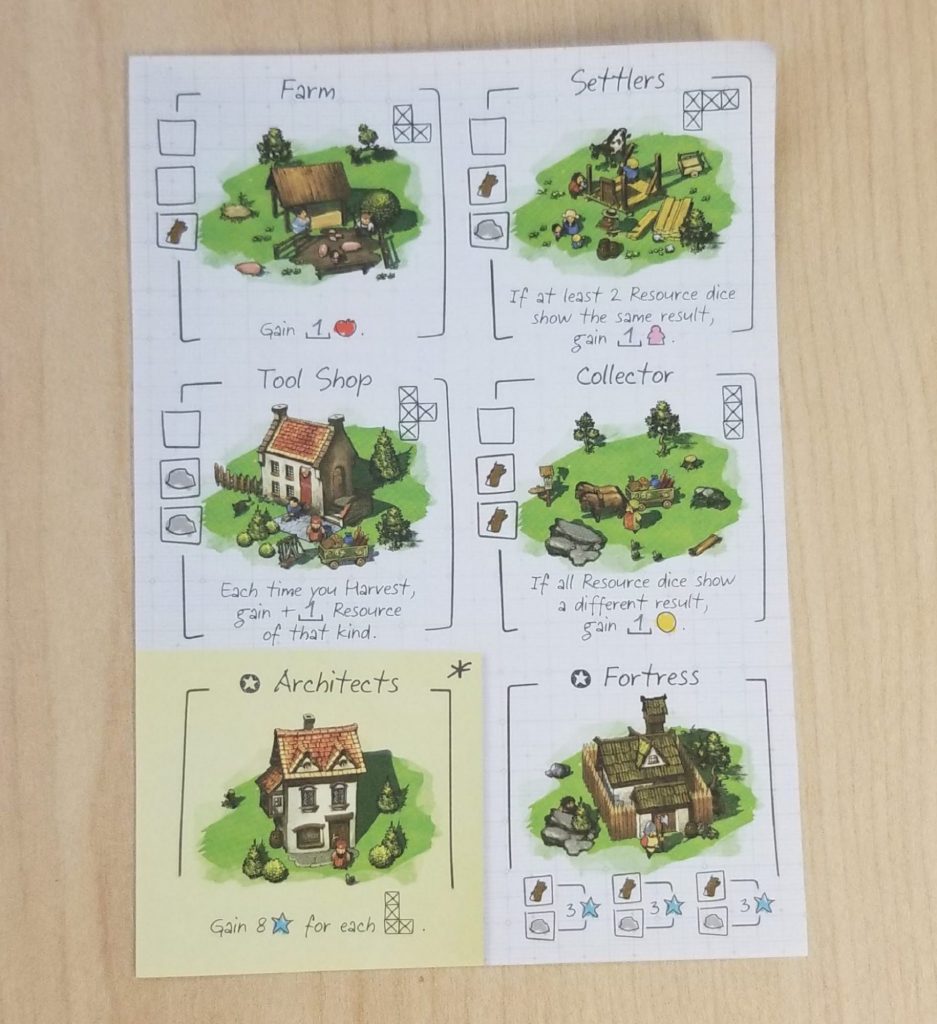
The Village sheet shows six different building types. The four buildings at the top of the sheet are available to be constructed and will cost the players actions and resources. For instance, building a Farm is going to cost you a total of 3 actions and one wood. Each box requires an action in order to fill it in. If the box depicts a resource, then that resource must be paid as the action is being spent to fill it in. Once all of the boxes are filled in, the building is considered to be “built” and will begin providing its unique benefit beginning with the next round.
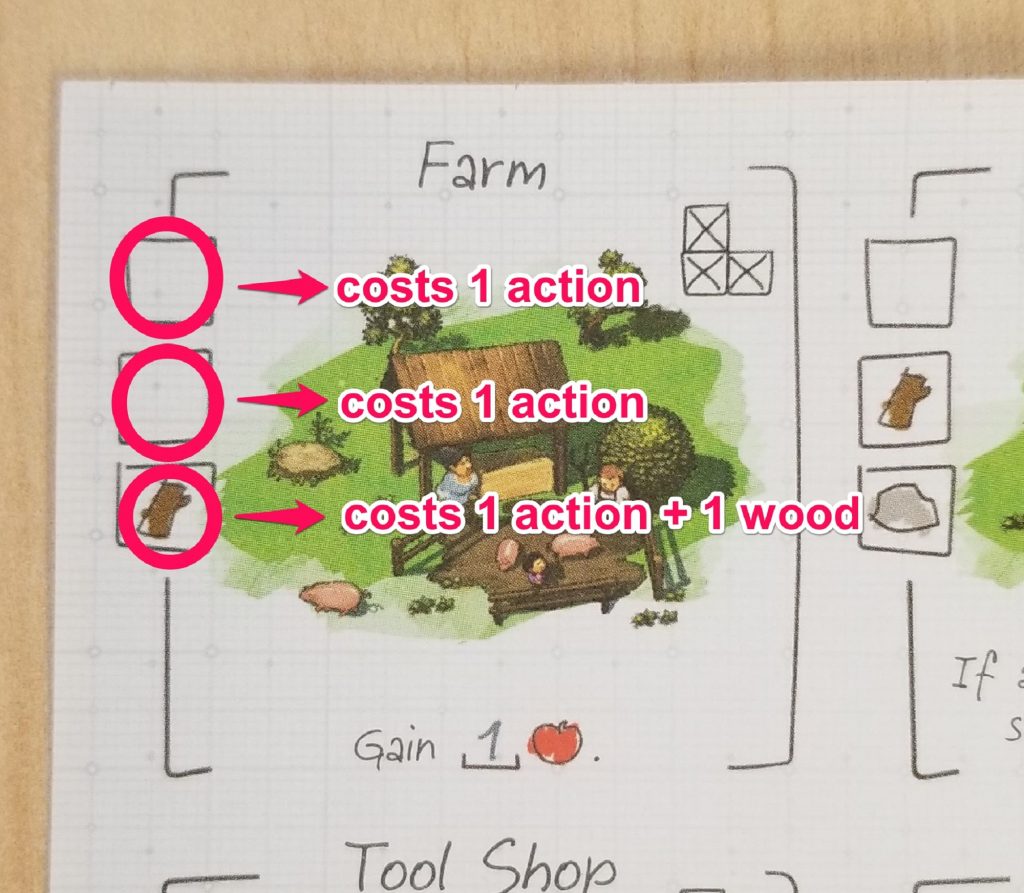
The bottom two buildings are considered to be already built and provide their benefits from the get-go. The bottom left building, Architects, is only used in the advanced mode which I will discuss later. The other building, Fortress, can provide victory points at the end of the game.
…And Empire Building
As stated earlier, the game consists of 10 rounds. At the beginning of each round, the dice are rolled. Then the start player will select one of the face up Favor tokens followed by the rest of the players in clockwise order. The Favor tokens provide some kind of benefit that can be used once during the round; free resources, extra actions, etc. Once the Favor tokens have been selected, the players then take turns performing actions until they can no longer do anything else. In game terms, this is the “Expand Your Empire” phase.
During this phase, the players will be able to perform as many actions as they want and are able to pay for. These actions fall into one of two categories: harvesting and building. To harvest, a player checks off one of the empty spaces in one of their fields and gains the resource(s) shown.
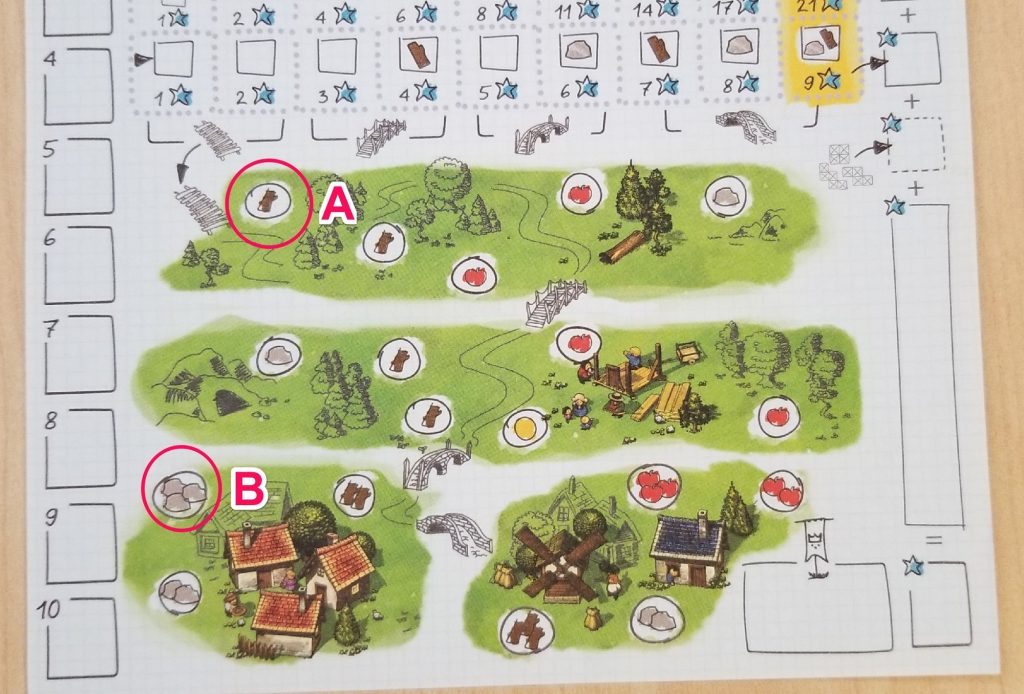
There is a caveat to this, though. In order to use a space in a field, the player must have access to it and this access is granted through the process of building. When building, you can either build things in the Construction area of the Empire sheet or you can build something on the Village sheet like the Farm that was shown previously.
The Construction area is divided into several rows. The first row is filled in using stone. The second uses wood and the third uses food. The fourth row is how you gain access to the various fields. For every pair that you build, a new field becomes available. Each field is represented by a different type of bridge image so it’s easy to figure out which fields you have unlocked and which you haven’t. When building things in the Construction area, you must always work from left to right. Using the dice roll depicted earlier, instead of building the Farm, you could choose to do something like this instead:

Two actions have been used to unlock the first field. The third action has been used in conjunction with the food resource to fill in one of the boxes on the first spot on the food row. Note that in order for the player to move to the next spot, they would have to fill in the other two boxes first. For the fourth action, the wood resource has been used in conjunction with the gold coin to fill in the first spot on the wood row.
When a round ends, the players mark off the current round on their Empire sheets, the Favor tokens are returned to the middle of the table, and the next player in clockwise order becomes the new starting player. At the end of the 10th round, the players total up their victory points and the player with the highest total wins. Each row in the Construction area provides points equal to the value of the highest completed level. In the example above, if the game were to end right then, the player would score 2 points for their wood row and nothing for any of the others. Additional victory points can be earned by completing sections of the Fortress (bottom right of the Village sheet) at the cost of 2 actions, 1 wood, and 1 stone for each section. These are worth 3 points each. Other points come from Favor tokens.
The Advanced Game
The advanced game is played exactly like the basic game with just a few extra rules. The advanced game adds a new phase that comes right before the “End of Round” phase called “Creating a Settlement”. In this phase, the players will be able to draw a shape around groupings of completed spots in the Construction area of their Empire sheets. The type of shape corresponds to the buildings on the Village sheet.
As an example: if you are an astute observer, you no doubt noticed that the Farm image has a strange Tetris-like shape printed next to it. This particular shape corresponds to Farms and if you decide to bound off this shape in your Constructions area, then you will be able to cross off the 1 in the Farm description and write in a 2 instead. Now that Farm will produce 2 free food each round.
Every other building has its own shape and, just like the Farm example, bounding off that shape during this phase will multiply whatever effects that building produces in future rounds. At the end of the game, your Empire and Village sheets may look something like this:
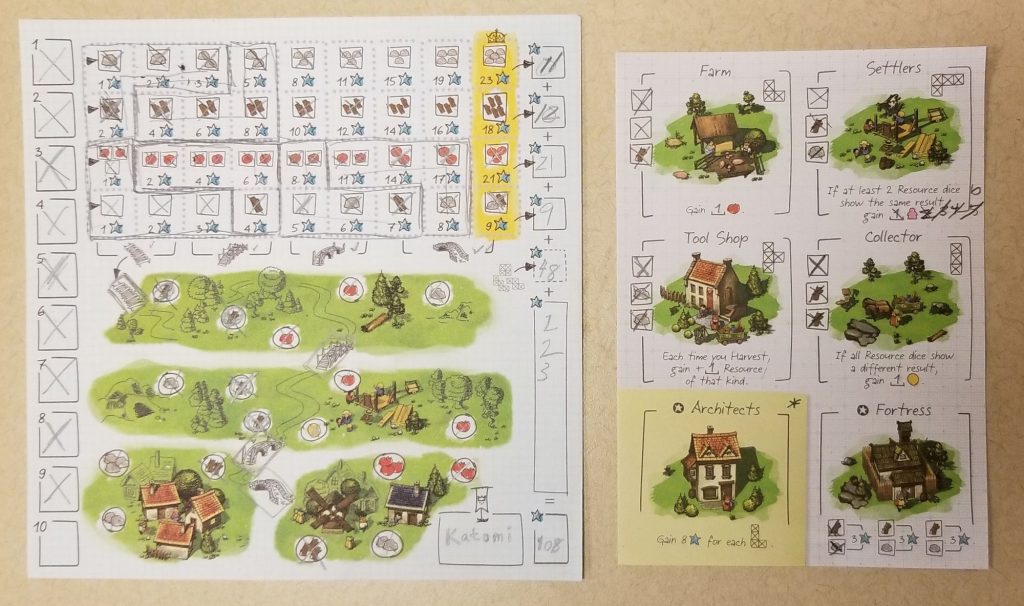
This player focused entirely on the Settlers building shape which not only provided them with a lot of potential for taking extra actions each turn but, when combined with the Architects building, netted them an extra 48 (6 L-shapes * 8 points apiece) points at the end of the game.
Thoughts
Imperial Settlers: Roll & Write sets out to capture the feeling of its titular inspiration in the form of a dice and paper game. While it manages to accomplish this in some regards, it completely misses the mark in others. If you’re playing this game because you’re a fan of roll and writes in general and less because you’re a fan of Imperial Settlers, then your expectations may not be as high as mine were. I’m a massive Imperial Settlers nerd and I was hoping to experience that game in an entirely new way. What I got was something that, while superficially similar, was a vastly different experience.
If I had to sum up my feelings about this game with an analogy, it would be this: Imperial Settlers: Roll & Write (IS:R&W) does for Imperial Settlers what Agricola: All Creatures Big and Small (AACBAS) does for Agricola. It takes one particular aspect of its big box inspiration and laser focuses on it while ignoring everything else. In this case, IS:R&W doesn’t concern itself with the asymmetric player powers or warfare aspects of Imperial Settlers. In much the same way AACBAS focused on the animal breeding aspect of Agricola, IS:R&W turns all of its attention to the engine building aspect of the game.
For an Imperial Settlers purist like me, this is kind of unfortunate. I like having the ability to raze other people’s stuff. It adds a lot of desperately needed player interaction to an otherwise solitary game. AACBAS can get away with omitting things. Agricola’s a game about raising crops and breeding animals. AACBAS just takes one of those aspects and creates an entire game out of it. It isn’t necessary to grow crops in order to breed animals so the gameplay still maintains the same character and feel of the game’s bigger counterpart. IS:R&W isn’t like that, though. Imperial Settlers isn’t just a game about engine building. It’s also a game about different factions squaring off against each other in order to become the dominant faction. Aggression is built into its very fabric. By omitting the aggression, IS:R&W doesn’t feel like an Imperial Settlers game at all. It could just as easily have been called Pokemon Roll & Write or Chewing Gum Roll & Write for all it has to do with its namesake.
Apart from a few hazy rules text situations that crept up, that is really my only complaint about the game. As far as the engine building aspect of IS:R&W goes, it exceeds all expectations, almost to its detriment. At the beginning of the game as you’re struggling to completely fill in the boxes on your sheets, it’s hard to imagine a scenario in which you’d ever be able to fill in the last box in the row. And then the magic kicks in. Before you know it, you’re in the middle of a round where you’ve got seven or eight actions and resources coming at you from every direction. The pace becomes frenetic and exciting as you’re filling a box here which nets you some benefit over there which you’re then able to apply in yet another place. And on and on it goes until you find yourself out of actions and out of options and then it’s on to the next round. That in itself isn’t so bad. The game does what it sets out to do and it does it very well.
The problem is that when you’re generating 15 wood and 10 stone and 9 food and 6 coin and 7 or 8 actions, it can become really hard to keep up with what all you’ve earned, what you’ve spent, where you’ve spent it, and how much is left. Without any kind of physical representations, it’s a lot of information to juggle and it can quickly start to feel overwhelming. When I was watching videos to try and learn the game, I saw several Youtube personalities scrounging the resource bits from other games. At first glance I didn’t think this was absolutely necessary but after having played a few times, I think I’m going to follow suit and I’d recommend you do so as well. This game almost needs another pad for you to take notes on so that you can keep up with everything.
Putting all of that aside, though, this is really an enjoyable game. It’s very easy to learn and even easier to teach. The box is small enough to fit inside of a backpack or a purse. Couple that with the game’s small table top footprint and you’ve got an awesome game that’s perfect for any occasion.


